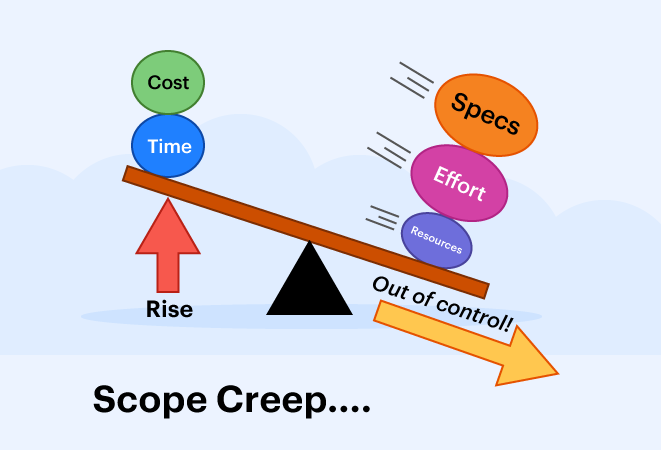Imagine you own a small landscaping company. A customer hires you to redesign their backyard, with the project to be completed within a week. You discuss the initial design, including laying new grass, planting flowers, and installing a small water feature.
After two days, the customer contacts you and requests the addition of a stone pathway leading to the water feature. You agree since you haven’t completed the project yet, and it shouldn’t take too long.
Later, the customer calls again and asks for more additions to the project. As you try to accommodate each new request, you realise the additional features have completely messed up your project schedule.
So, what is happening here?
Scope creep is sneaking its way into the project. The initial plan and project scope keeps changing, with new features added without proper timelines or budget adjustments.
Sadly, this isn’t just an issue for landscapers. Developers of software projects, in particular, can find themselves grappling with this problem.
So, in this article, we’ll dive into the world of scope creep and its impact on projects. We’ll explore three different software development methods, taking a closer look at the aspects of each that might be prone to scope creep, while also highlighting ways in which scope creep can be kept under control.
Also, we’ll share our top tips and best practices for effectively managing and preventing scope creep in your projects.
What Is Scope Creep in Project Management?
Scope creep, also known as requirement creep or feature creep, is the unintended expansion of a project’s scope beyond the initial requirements.
These changes can mess with the project schedule, budget, costs, and resource allocation, possibly putting milestones and goals at risk. It’s one of the most common issues project managers face.
Why Scope Creep Occurs
Scope creep risks causing serious harm and project failure. Various circumstances can trigger scope creep, and we’ll expand on some of the most common causes.
⚠️ Poorly defined project requirements: Clarity is critical to the success of any project. Without a clear work breakdown structure at the beginning, you risk causing significant disruptions down the line.
⚠️ Inadequate communication: As the project begins, ineffective communication between stakeholders, project teams, and project managers can cause the project scope to mutate as different parties have different expectations or assumptions about the project’s goals.
⚠️ Stakeholder requests: As the project progresses, stakeholders might request new features or changes that were not part of the original plan, which causes the project to drift away from the agreed-upon scope.
⚠️ Gold plating: This occurs when project team members add extra features or functionality to a project without authorisation, attempting to exceed expectations or make the end product more attractive.
⚠️ Lack of a change control process: A lack of an effective change control process can make it challenging to manage scope, allowing changes to be introduced without proper evaluation of their impact on the project timeline.
The Impact of Scope Creep on a Project

Scope creep can have several negative consequences on a project, such as:
⚠️ Running over budget
⚠️ Schedule delays and missed deadlines
⚠️ Decreased quality of work
⚠️ Low team morale that leads to reduced productivity
⚠️ Reduced stakeholder satisfaction
⚠️ Difficulty in project management
⚠️ Potential project failure
It’s one thing to talk about how scope creep operates, but we believe it’s even more helpful to see it in action.
So, let’s dive into some examples of scope creep in popular software development project methodologies, giving you a clearer picture of how it can unfold in real-world scenarios.
Examples of Scope Creep in Software Development
The three most common software development frameworks are:
➡️ Waterfall
➡️ Agile
➡️ Wagile
We’ve covered these methodologies in greater depth elsewhere. Still, in the following sections, we’ll touch upon each method, examining their unique approaches to preventing and being susceptible to scope creep.
Waterfall Method
💡 What is the Waterfall Method?
The Waterfall methodology, also called the Waterfall model, is a linear project development approach that progresses systematically through distinct stages of a project, such as analysis, design, development, and testing.
In this method, each stage is fully completed before proceeding to the subsequent stage, resembling the continuous flow of a waterfall.
One of the advantages of the Waterfall method is that the project scope, timeline, and budget are very clearly defined at the beginning of the project.
Its structured approach and emphasis on planning, control, and communication can help minimize the risk of scope creep in projects where requirements are well defined and unlikely to change significantly.
That said, it’s not immune to scope creep. Below is an example:
Example of scope creep in a project using the Waterfall model
Using the Waterfall methodology, a company develops customer relationship management (CRM) software. The project comprises several phases: requirements gathering, system design, implementation, testing, deployment, and maintenance.
During the requirements-gathering phase, the project manager and stakeholders define the software’s features, such as contact management, lead tracking, and reporting capabilities. The project scope is documented, and the team proceeds to the system design phase.
However, after the implementation phase, a key stakeholder realises integrating the CRM with their existing email marketing platform would be highly beneficial. They request that the development team add this feature to the project.
Since the project is already in the implementation phase, incorporating this new requirement is challenging and time-consuming, causing it to deviate from its original scope.
As a result of the scope creep, the project experiences delays, cost overruns, and increased complexity. The inflexible nature of the Waterfall methodology makes it difficult to accommodate these changes efficiently, ultimately impacting the project’s overall success.
What went wrong?
The main issue in this situation is that there wasn’t a robust strategy for accommodating changes. As we’ve mentioned above, Waterfall development projects have very little flexibility.
Because of the rigid structure, a proper change management process must be in place for when changes need to happen.
A lack of a formal change management process can lead to inadequate impact analysis, where changes are implemented without considering their consequences on the project’s timeline, budget, and resources, potentially causing increased project scope, delays, or cost overruns.
Agile method
In agile projects, the scope remains variable to allow for incremental development and feedback-driven improvement. This is because the key to agile is the ability to respond to changing business needs quickly.
Because agile embraces change, does that mean scope creep is nonexistent? The answer is not a clear-cut yes or no.
💡 What is the Agile Method?
The Agile method is a project management and product development approach that prioritizes flexibility, collaboration, and iterative progress.
It emphasizes adaptability to change, continuous improvement, and delivering small, incremental portions of a project or product, allowing teams to respond more effectively to evolving requirements and feedback.
Agile projects can still experience scope creep, but the impact may be less severe.
Here is a working example:
A software development company is working on a mobile app for a fitness centre using the Agile methodology. The app’s primary features include class schedules, personal training bookings, and progress tracking.
The project is divided into two-week sprints, and the team starts working on the first sprint, focusing on the highest-priority features from the product backlog.
During the third sprint, the fitness centre’s management decides they want to include a feature that allows users to track their nutrition and meal plans. They propose this new feature to the development team.
The team evaluates the new requirement, estimates the effort needed to develop it, and adds it to the product backlog. The team then reprioritizes the backlog and plans to address this feature in an upcoming sprint without disrupting the project’s progress.
In this example, the Agile methodology’s adaptability and iterative nature enable the software development team to effectively manage scope changes, keeping the project on track and delivering a more successful final product.
Yes, scope creep is possible in Agile projects
What we haven’t emphasised in our discussion so far, is that the examples we’ve provided assume that budget and time are not significant constraints when developing digital products.
In an ideal world, these limitations wouldn’t exist, as an Agile project could potentially continue indefinitely. However, most founders and project stakeholders have strict budgets and time constraints to consider during planning.
In this context, scope creep can still come into play in an Agile project, as accommodating additional features or changes without considering the available resources and deadlines can lead to project delays and budget overruns.
The Wagile method might be the solution
While both the Waterfall and Agile methods have a lot of positives, Wagile may just be the best approach to preventing scope creep!
What is the Wagile Method?
The Wagile method is an informal term referring to a hybrid project management approach that combines elements of both the Waterfall and Agile methodologies.
Wagile takes the best aspects of Waterfall:
➡️ Well-structured projects with linear phases
➡️ Comprehensive documentation
➡️ Defined deliverables and milestones
And combines them with the best features of Agile:
➡️ Flexibility
➡️ Rapid value
➡️ Continuous release
While no project methodology is entirely immune to scope creep, some features of a Wagile project can help mitigate its impact:
👍 Clearly defined project scope from the start
👍 Usually incorporates a formal change management process
👍 Sprints include regular reviews and checkpoints
👍 Prioritization of features and tasks based on their value and importance keep things on track.
If you aren’t using the Wagile approach, don’t worry! Below, we’ll delve into practical strategies and tips that can help you avoid scope creep and run a successful project.
Best Practices for Preventing Scope Creep
Navigating the ever-changing landscape of software development can be a wild ride, and keeping a project on track is never easy. Below, we’ll share our best practices for dodging scope creep in software development projects.
🟢 Define clear project objectives
A scope statement is a document that clearly defines and outlines the objectives, deliverables, and boundaries of a project. A good project scope usually includes:
➡️ Project objectives: The objectives should clarify the project’s requirements. This means stating why the project is being done, what will be done, when it will be done, and how much it will cost.
➡️ Deliverables: This section will address the actual outputs. A separate document – the work detail structure – will outline the specific activities associated with a particular deliverable.
➡️ Project boundaries: The boundaries clarify what is in scope (included) and what is out of scope (excluded) for the project.
➡️ Constraints: A good project scope will define the limitations or restrictions that may affect the project, such as budget, resource allocation, and timelines.
➡️ Assumptions: Any factors or conditions assumed true for the project’s success. These assumptions should be updated and validated as the project goes on.
🟢 Involve stakeholders early, and often
It’s important to ensure you understand what a stakeholder wants from day one. Miscommunication can happen easily!
Take the time to engage stakeholders early in the project planning process to ensure what they have asked for is included in the project scope. This can help minimize the likelihood of significant changes later on.
It’s also important to educate project stakeholders to understand the impact of scope changes on the project. Clarifying the impact can help to minimize the number of change requests and promote a shared understanding of the project’s constraints.
💡 Don’t forget your team! Poor communication is a project killer. Maintaining open and transparent communication with team members is just as important as communication with key stakeholders.
🟢 Establish a change control process
Change is inevitable, and every project needs a process for what happens when the change requests roll in. To do this effectively, project managers need to have a formal change management process that defines the procedure for managing scope when the project plan changes.
Here is a very simplified way to create a change control process:
➡️ Define change control procedures: Begin by outlining the procedures for handling change requests. The plan includes all the steps for submitting, evaluating, approving, implementing, and documenting changes. This plan needs to be clearly defined and communicated to all stakeholders.
➡️ Appoint a change control board: Designate roles and responsibilities for managing change requests. This may involve appointing someone like the project manager or project sponsor to review, approve, and oversee changes.
➡️ Create a change request form: Develop a standardized form or template for submitting change requests. This form should capture essential information such as a description of the change, the reason for the change, the impact on the project (in terms of time, cost, and resources), and any risks associated with the change.
➡️ Establish evaluation criteria: Identify the criteria for evaluating change requests, such as alignment with project goals, a cost-benefit analysis, potential risks, and impact on the project schedule.
➡️ Implement a review and approval process: Set up a process for reviewing and approving change requests.
➡️ Communicate changes: Once a change request has been approved, communicate the decision to all relevant stakeholders.
➡️ Update project documentation: Update the project documentation – including the project scope, schedule, and budget – to reflect the approved changes.
➡️ Monitor and control: Continuously monitor and control the implementation of approved changes to ensure they are executed as planned, and their impact on the project is managed effectively.
🟢 Task prioritisation is a must
When you have to make changes, make sure that your project manager has a process for prioritising which features or updates will bring value to the end user.
Prioritisation helps to focus resources on the most critical aspects of the project and minimize the impact of non-essential changes.
🟢 Set flexible but firm boundaries
You might have experienced this before: “Since you’re already working on that…” or “While you’re at it, could you also take care of this?” or our favourite “It shouldn’t take too long”.
While some changes may be necessary to accommodate new information or requirements, don’t fall into the trap. To avoid scope creep, be firm in managing the project scope and resisting changes that do not align with the project’s original goals or add significant value.
MOHARA Can Help
So, just like a landscaper dealing with a tricky client, scope creep can sneak up on you in software development, too. When project requirements change without proper control, it leads to potential delays, budget overruns, and compromised quality.
But don’t worry! By getting a good grasp on how different software development methodologies handle scope creep and using the right strategies to manage changes, you can keep your projects running smoothly.
If you’re a founder looking for a partner who knows the ins and outs of the product development process and has the know-how to manage scope creep, why not get in touch with us? We’d love to chat!











